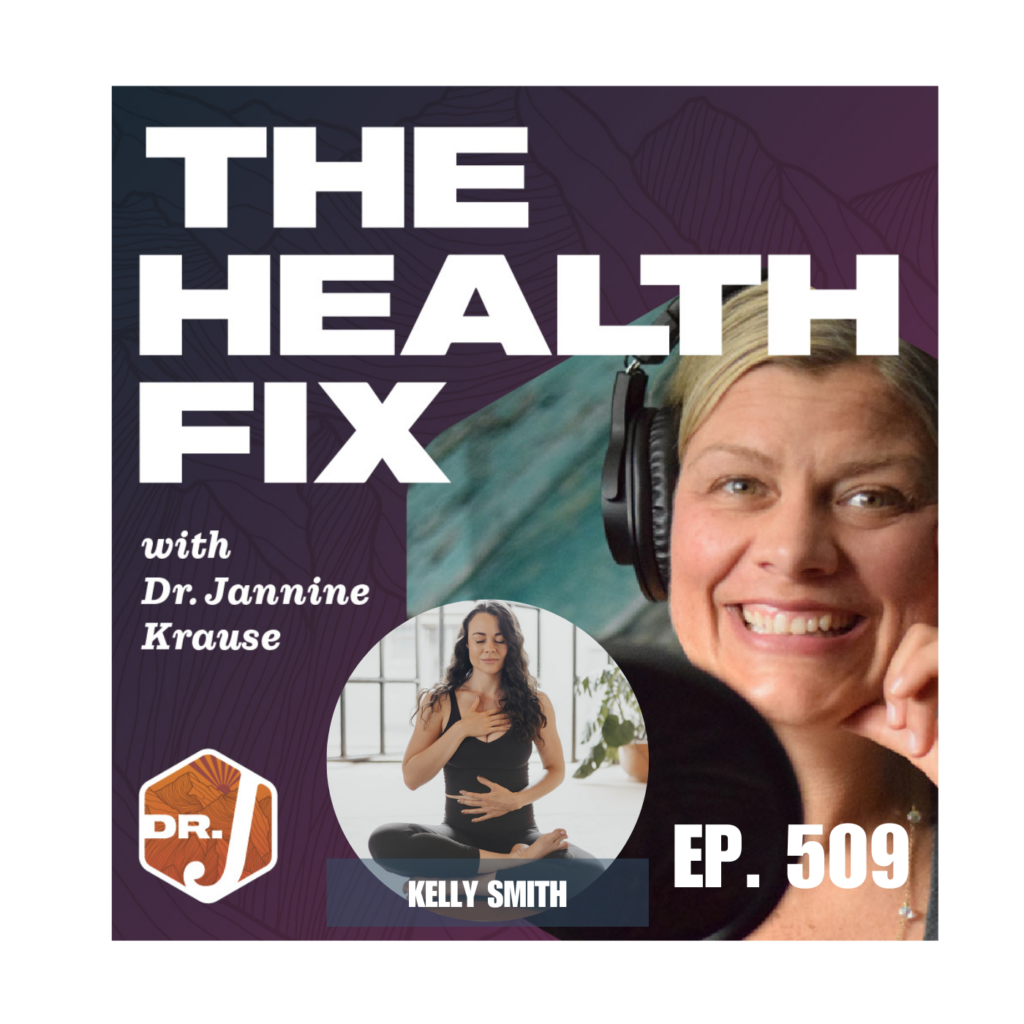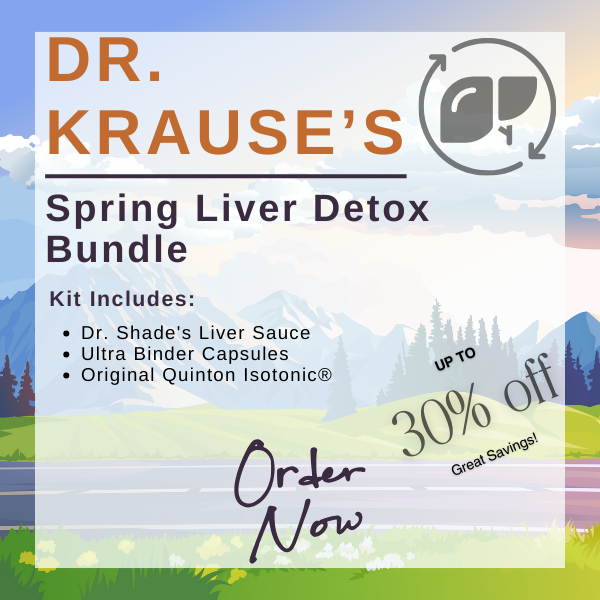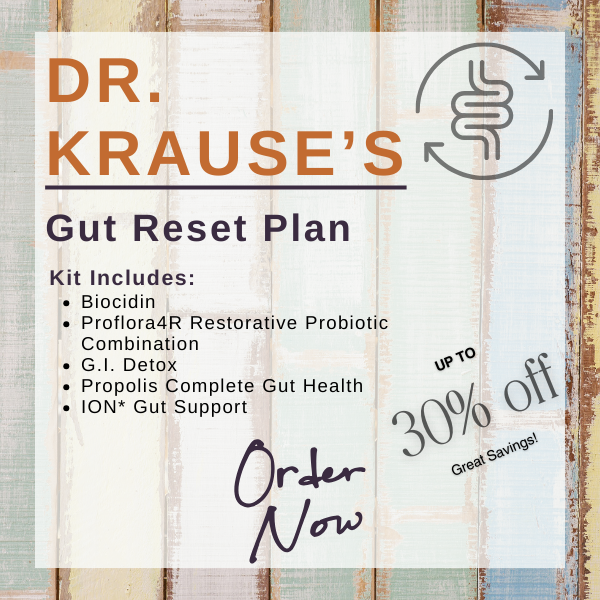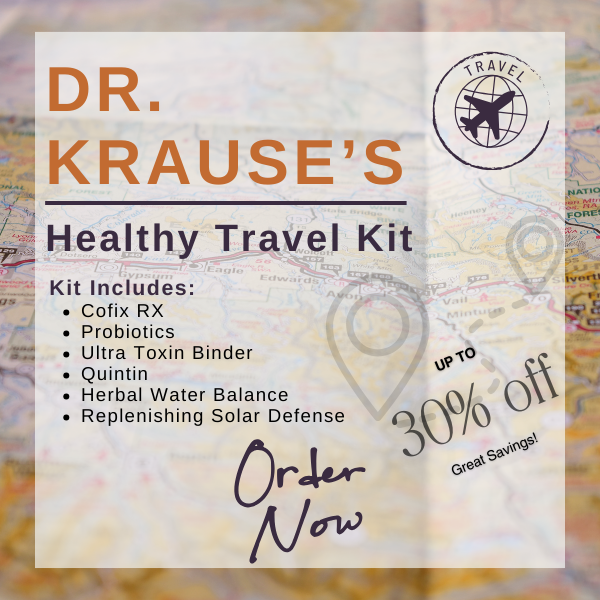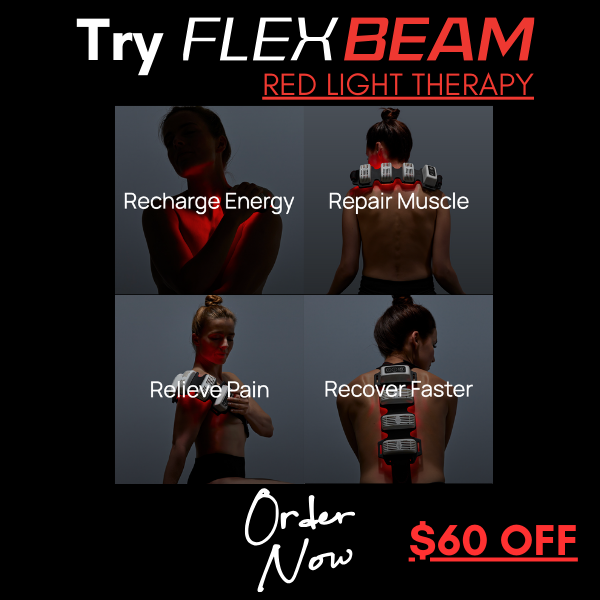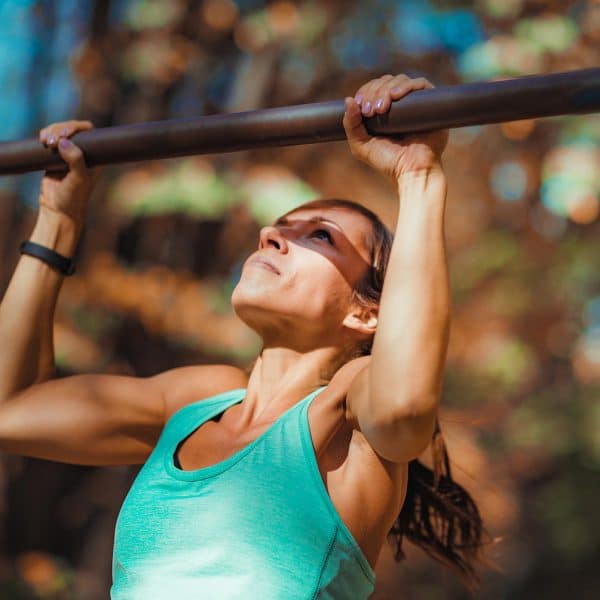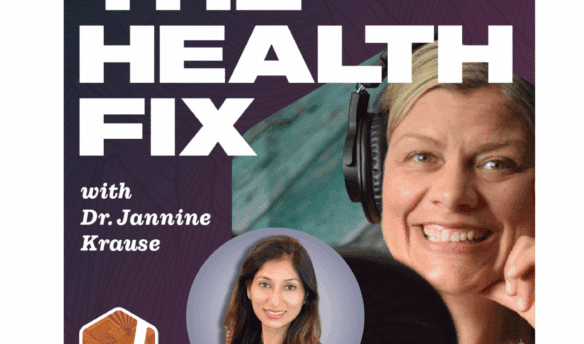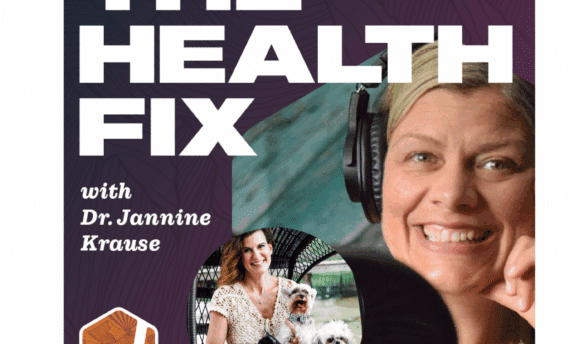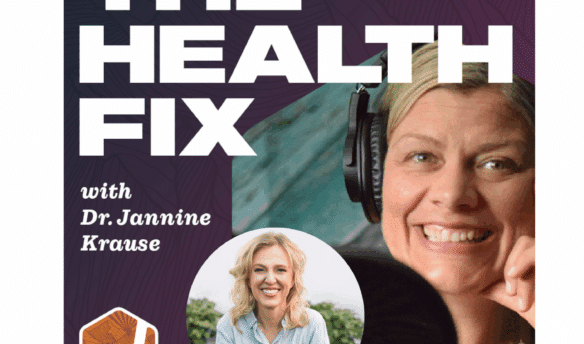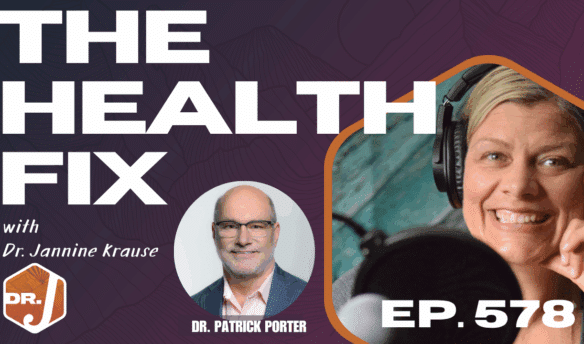Introduction:
Looking for a way to restore balance in your body, tap into deep, reparative sleep, and uncover insights from your subconscious mind? In today’s episode, we dive into Yoga Nidra with Kelly Smith—mom, globally celebrated yoga and meditation teacher, and founder of Yoga For You. Kelly is also the host of the iTunes chart-topping podcasts Mindful in Minutes and Meditation. With her down-to-earth meditation instruction, Kelly encourages people to discover their unique yoga and meditation practice, listen to their bodies, and tap into inner joy.
In this episode, I share my own experience of trying Yoga Nidra for the first time—on a plane! Kelly challenged me to a “joy and happiness” session, and though I fell asleep the first time, I completed it the second round, feeling a profound sense of joy and peace. The woman next to me may have thought I was a little nutty, but I didn’t mind—it felt amazing!
Dr. Krause’s Protocols
Instructions Included
Traveling soon? Looking to detox or reset your gut? Try one of Dr. Krause’s Fullscript plans.
What You’ll Learn In This Episode:
- How Yoga Nidra allows you to access your true self while your body enters a sleep state
- Why meditation helps train your mind to refocus after distraction
- The surprising benefits of just 8-10 minutes of meditation a day for your physical, mental, and neurological health
- How to use Yoga Nidra to reduce “food noise” and emotional eating triggers
- The power of regular Yoga Nidra sessions to check in with your subconscious mind
Resources From The Show:
- Kelly Smith’s Website – Yoga For You:
Yoga For You - Mentorship, Private Sessions, and Retreats:
Work With Kelly - Mindfulness in Minutes and Meditation Podcasts:
20-minute guided meditations to fit your busy schedule
Listen Now - Book – Meditation for the Modern Family:
Check it out
Our Partners
Podcast Transcript
4:17 – What is yoga nidra?
12:31 – “Meditation is training your mind to be able to focus on something for longer amounts of time”
14:21 – Guided meditation and Kelly’s Mindful in Minutes Podcast
16:32 – How to incorporate yoga nidra into your life
20:44 – What else can yoga nidra help with in life?
25:25 – Can you manifest optimal health? PTSD
30:20 – Food guilt
34:35 – How long has yoga nidra been around?
41:49 – Silent retreats and the “vow of silence”
47:51 – How Kelly got into yoga nidra
54:18 – Kelly’s books
100:25 – Information about Kelly’s retreats
[Preview] And studies tell us we only need eight to 10 minutes a day to get the physical,
mental and neurological benefits of meditation.
I hope you need to really shines when it comes to improving your sleep,
um, restoration of like the tissues of the body.
Because again, your physical body is like falling is going to sleep.
And anyone who is, you know, a nerd like me, um, and loves like the science of
sleep, it gets you to that like deep sleep state for your body,
which is where tissue regeneration is happening.
So, essential is like our hormone function.
I mean, that deep sleep, also light sleep, really important too, because that’s where we just rest.
So, a lot of people come for the physical benefits of like helping to regulate the nervous system,
regeneration of the tissues, slowing down, getting rest, and just like chilling out.
[Intro] Welcome to the HealthFix podcast, where health junkies get their weekly fix of tips, tools,
and techniques to have limitless energy, sharp minds, and fit physiques for life.
JANNINE: Hey, health junkies. On this episode of the Health Fix podcast, I’m interviewing Kelly Smith,
and we’re going to be talking about yoga, knee draw. Kelly is a mom, as well as a globally
celebrated yoga and meditation instructor. Now, she’s also the founder of yoga for you,
and the host of the iTunes chart-topping podcast, Mindful in Minutes and Meditation.
Kelly’s books, podcasts, and trainings have been featured in places such as NPR, Forbes,
Yoga Journal, Meditation Magazine, and the Lavendaire Lifestyle YouTube channel.
And now she’s going to be on the health fix.
Now prior to my interview with Kelly, I had never tried yoga knee-dressed.
So Kelly was like, you got to do this before you air this podcast.
And sure enough, I tried it out.
Now the first time I felt deep asleep, which is kind of funny, you’ll hear why in the
podcast.
And in the second round, I felt the feels, felt the emotions, loved how my body felt
while it was asleep and my conscious mind was awake because that is the concept of yoga
nidra.
Body goes to sleep, conscious mind comes up with things for you.
Kinda cool.
So the woman next to me on the airplane where I tried it probably thought it was nuts, but
that’s okay.
I don’t mind.
You know why it felt really good?
I was totally relaxed and joyful since that was the purpose of the particular yoga,
nidra meditation.
So let’s introduce you to Kelly Smith so you can learn more about yoga nidra and
guided meditation.
Let’s get on with the podcast.
Kelly Smith, welcome to the health fix podcast.
KELLY: Hi, how are you doing?
JANNINE: Oh my goodness.
Well, good.
Even better now that I’m chatting with you, we have had such a lovely conversation already.
So I have no doubt we’re going to have some fun today.
And folks, we’re going to learn about yoga nidra, something
that I’ve never talked about.
KELLY: I am so excited, also so honored to be your first yoga
nidra guest.
We were chatting before this.
And I said, I love to be people’s gateway
drug to meditation, but also to yoga nidra.
I love first timers.
JANNINE: It’s good stuff because I fully disclosed
that I have never done yoga nidra.
I’ve heard of it.
I have completely been like, yes, people go get it.
Sounds amazing.
And it’s one of those cases in which I usually try everything
before I recommend it.
But in this case, I never had the opportunity
because either the classes were while I was working
or weekends were adventuring and I just couldn’t make it work.
So that’s what happened in this case.
But nevertheless, today we’re gonna bring everybody,
including myself up to speed.
KELLY: I love it.
will email you an audio recording of a full yoga
ninja practice so you can try it.
JANNINE: Awesome. So you guys will get to hear what happened in that
session at the end of this podcast. I’ll give you guys the
full update. So so tell us a little bit about how you came
to develop a love for yoga. And when did you first try it?
And maybe even tell us what it is to because I think in this
part, I might put a little teaser in the intro, but I think it
be good for folks and I’m like, what is yoga nidra and when did you first try it?
KELLY: So yoga knee-dra is this really beautiful practice where you, it’ll feel like a long guided meditation.
You’re going to lay there and listen to the sound of a facilitator’s voice for 30 to 60
ish minutes.
And what you’re doing is you’re taking a conscious journey through what we call in the yoga world,
your koshas.
That’s just a Sanskrit term for layer or sheath.
And think about it as we have these different layers, right?
It sounds cliche to be like, we’re like an onion.
You peel back these layers.
I think of it as like those little Russian nesting dolls.
You know, you have like the original
and then all those other ones.
And yoga nidra is a practice in which you’re being led
through our different layers.
So it starts with the physical layer.
So when you walk around, you see someone
who say hi to them on the street,
you’re seeing their first kosho, their physical body.
Then it goes a little bit deeper into their energetic body.
Then you go into their mental body, their thoughts.
Then you go into their wisdom body,
which I always think is so interesting
that your thoughts are not wisdom.
You have to move past your thoughts
to really get into wisdom.
Then you move into your bliss body.
And the thing that lies beyond that is the true self.
And one of my favorite things to do
is to help people connect with the true self.
I think the more that we’re connected with our true selves,
kind of the magic of life unfolds.
You’re happier, you’re more aligned with who you are.
But the practice of yoga nidra is just this conscious journey
through the different layers to bring you face to face
with your true self, where you’ll plant a positive seed
of intention, or we call it a sand culpa.
That can be anything.
It can be something very broad, something like,
I move through life with confidence
or it can be something really specific.
Like I once did a private yoga nidra practice
And our San Copa was I walked down the aisle at my wedding
with confidence and ease.
She had very severe social anxiety.
It can be like really specific.
But you also get this beautiful benefit
of having all of the kind of nervous system
calming qualities of this practice.
There’s no movement.
It’s just you lay in Shavasana,
you get set up like this little yoga sleepover.
So you’ll hear me on the recording, I’ll send you.
I’ll say get cozy, you can even do it in bed if you want.
You’re gonna lay there.
And you’ll just start going through different exercises.
You usually do a rotation of awareness through the body.
You’ll do a little bit of a calming breath,
some kind of a breath technique.
You’ll do a little bit of a motion work.
You do these opposing feelings and sensations.
And then you go into some imagery.
And then once you’re done with imagery,
you plant that seed of intention
and hopefully get a little time
to be with your true self.
So it’s very calming, very relaxing.
and yoga knee drug, which translates to yoga sleep.
It actually does help to improve your sleep,
quality and duration.
And there’s these really interesting studies that show
when you’re practicing yoga nidra,
your body goes to sleep, but your mind still stays awake.
So you get those really great restful qualities
of having a deep relaxing experience.
Kind of like, I do describe it kind of like
when you have acupuncture.
So I love that we’re talking about this together.
you get to that really kind of like deep state where it’s almost like one foot in the sleeping
world, but like one foot in the awake world and you’re kind of, you know, leaning forward
and back in between these two worlds.
Like that’s physically where we get with yoga, knee draw.
And then when we’re in that relaxed state, we start unpacking some of those layers and
coming face to face with the true self.
JANNINE: Oh, how cool.
See, in my mind, and this is, this is good that now I’m knowing like yoga sleep.
Okay, that makes sense to me.
That kind of gives me a sense of like, oh, okay.
So we’re not going through all these yoga positions
because I think a lot of people,
anytime there’s yoga in front of something,
you’re gonna think that there’s a bunch of different poses
and things you have to do, right?
So the fact that you don’t have to do a bunch of poses,
that’s cool.
The fact that you’re really cool.
Shavasana is probably my favorite yoga position,
just saying, I think a lot of people might like that one.
You know, it’s all joking aside.
It’s just the most relaxing for me, right?
And I think for a lot of people just really laying down
and getting that moment in the day to relax is awesome.
KELLY: Yes, but an alternative thought to that
is I actually hear from a lot of people,
Shavasana is the hardest for them
because they, and this is usually,
and I fall into this category.
I used to be a Shavosna skipper.
This was well before my yoga nidra
Days.
And to answer the short answer to when did I first get into yoga
nidra?
You want to say it was maybe 10ish years ago.
I tried it at a local yoga studio.
And then when I did my second yoga teacher training for an
additional 300 hours, it was part of the curriculum.
And I was really like, oh my gosh, this is super interesting.
And since I’m neuro divergent, I have ADHD.
I love hyper fixation.
So then I decided this was cool.
I’m going to learn everything about it.
And one thing led to another and before you know it,
now I lead yoga nidra teacher trainings.
But I find that sometimes people struggle
with the idea of yoga nidra,
’cause the idea of laying there
with your thoughts trying to relax for,
you know, 45 to 60 minutes kind of sounds like torture.
When I first started doing yoga, granted I was so young,
my mom had to drive me to like my first yoga class.
I was there for like, you know,
the stretch for cross training for my sports.
But it was Savasana at time.
I was so bold.
I would roll up that mat and I would just walk out the door
and be like, OK, I got what I needed.
Goodbye.
And like now I was like, you know, a 30 something woman.
I would never I would never be so bold, but like a 14 year old
at a yoga class.
I’m like, bye, see ya.
And I know for a lot of people, it’s really it is hard to slow down
and to even give yourself that time in a full like 45 minutes.
I mean, I have, you know, two kids, a three-year-old in an infant, and like 45 minutes.
That sounds like a big time commitment.
But the thing that is so cool is that even if that’s hard for you, yoga, nidra, it like
it holds your hand all the way through.
There’s not like, “I’m just going to leave you with your thoughts.
It’s we’re moving through the body.
Now we’re going to do some breath work.
Now we’re going to do that.”
It holds your hand all the way through.
what’s really interesting is the time passes really quickly because we take in the sense
of time through our senses.
So I know that even when we’re talking now, five minutes from now, I’ll know, well, we
were talking about this.
Now we’re talking about that.
Time has passed or I can see through my window, trying to end the day.
Oh, it was light when we started.
Now it’s dark.
Time has passed.
And the thing that’s really cool is when you’re practicing yoga nidra, it’s a really intense
practice of what we call Pratyahara, which just means withdrawal of the senses.
So we are shutting our senses off and so you don’t understand
The passage of time in the same way and it goes by really quickly
Which I think is super cool and as someone again who has ADHD and little kids over stimulation is like
My jam I live in like over stimulation city and so to consciously shut down my senses feels
phenomenal. JANNINE: I
I could see that and that’s probably why I like working on being quiet and calm.
But because I realize I’m not the same as everyone else, but also I hear a lot of patients
coming to me and saying, “Hey, Doc, I’ve tried this meditation thing.
I don’t know what to do.”
Really with my thoughts, I don’t know where to go with them.
And then what if something is intense for me?
Where do I go from there?
So this sounds like the process.
And I love that you were talking about the little Russian dolls, like the Nesting Dolls,
like taking one layer of taking the other.
I mean, it’s, it makes sense and in such a great visual.
So folks who are listening to this and going like,
I don’t know, I failed meditation,
but this one might be good because you’re talking me
through things and we get past the senses of time.
KELLY: And I wanna first circle back to those people
who feel like they failed meditation
because my first love is meditation.
I am a meditation teacher.
And what I would say, and I love people,
and I go to like a dinner party or something,
and people find out what I do,
it’s always gonna happen, they’ll go,
“Oh my gosh, that’s so cool.”
I tried meditation once, but,
then I love hearing what follows the butt.
It’s always something, but my brain is too busy,
but I didn’t like it, but I have ADHD.
But I don’t know how to shut my mind off,
but insert whatever the reason is.
And you can never fail meditation.
It’s just single pointed concentration,
and chances are you just haven’t found the style that resonates with you yet.
Meditation isn’t about shutting off the brain or turning off your thoughts.
It’s about being able to get distracted and then come back.
Get distracted, come back.
It is training your mind to be able to focus on something for longer amounts of time.
And so that might be every four seconds when you start, you get distracted,
but then you come back.
And then before you notice every 10 seconds, maybe every 15 seconds.
And if you’re the person, you’re like, I didn’t know what to do, I would go find a guided meditation and find something where just like with yoga,
nidra, they’re going to walk you through the whole process.
And I think you’ll find a little bit more success.
But I wanted to just speak to those people because I hear this all the time too.
And you can never fail meditation.
Just like, you know, you can never fail acupuncture.
You can never fail.
Trying your best.
You know, you know, you don’t fail at that.
JANNINE: No, it’s, it’s true.
It’s true. It’s, it’s one of these things where, you know, I think we just,
we get in our heads a lot and we’ll say different things and, you know,
whatever happened happened, right? But, but I’m going to plug your podcast right
now because guys, she has a podcast called mindfulness in minutes.
It’s 20 minute guided meditations and like,
I think guided is a great way to go when you’re really trying to dip your toes
in and really get a habit of slowing down happening.
I don’t know how you feel about it, but obviously you’ve got your podcasts.
So my guess is it’s probably something you would recommend.
KELLY: It is a thing that I love and yes, mindful in minutes,
it’s all, there’s even like five minute practices.
It’s all with the exception of a couple of yoga nidros
on there which are longer.
They’re all less than 20 minutes.
And the reason that I designed it that way is one,
again, I have ADHD, I need a, I’m a meditation teacher
and I still like a short get right to it practice.
There’s been different seasons in my life
I’ve liked longer right now when I have primary parent to two little kids.
Down and dirty is the way I like it right now in terms of meditation.
But I also think that it’s so special to have someone to walk you through the process,
especially when you’re starting. And studies tell us we only need eight to 10 minutes a day to get
the physical, mental, and neurological benefits of meditation. That’s all that we need.
And there’s some really interesting research from Sarah Lazar coming out of Boston.
And she’s the one that looks at meditation in the brain and what’s actually effective
What do we actually need and you only need 10 minutes?
And I promise everyone can find 10 minutes, which is you know why?
Seven years ago, which you know, we both know is like geriatric for a podcast
I started creating this thing making these short guided meditations is it’s all that you really need
JANNINE: Wow, wow seven
I mean, I’m thinking seven years of
podcasting that’s impressive.
And then the couple of minutes a day,
I don’t, I think a lot of people really do get hung up on,
on the timeframes.
‘Cause if you search on YouTube,
it, you could look for a meditation at any certain minute,
but you do see that there’s a lot more
that are like 20 minute plus in terms of things.
So– KELLY: You don’t need that.
JANNINE: That’s huge.
Yeah, that’s huge.
KELLY: Yeah.
JANNINE: So with yoga nidra being a little longer.
I’m also gonna kind of insert how often is it recommended
to do something like yoga nidra?
How would you incorporate into your life?
KELLY: The way that I like to incorporate it
and you might get different answers from different teachers.
The way that I personally like to use it
is maybe a couple times a month.
I think that it’s something,
it depends if I’m working with like a one-to-one client
and they’re working on something really specific.
Like the woman where we were working on her,
being able to walk down the aisle at her wedding and move past her social anxiety.
That was something where she listened more frequently, kind of leading up to that actual
day.
I do think that for a lot of people once a month or maybe twice a month is really great
and also realistic because it is a longer time commitment.
You’re going to need 45 to 60 minutes to do it.
But it’s kind of up to you.
I know a lot of people that have, you know, some of my most popular podcast episodes are
the yoga nidra for sleep. A lot of people would use it almost every night to listen to,
to fall asleep, which isn’t cheating. People will say, “Well, is it cheating or does it,
you know, it doesn’t count if I don’t listen to the whole thing?” No, if your goal with yoga
nidra is to fall asleep, then great, then use it to fall asleep. That’s great. That’s amazing.
So people sometimes use it daily, especially if they’re going to use it to fall asleep,
or when they’re having a hard time sleeping, I personally feel like a couple times a month is
really great. But one thing I want to flag for people is when you practice
yoga knee dress, something that will happen often is you will fall asleep. I
do you know local pop-up classes here in Minneapolis where I am with yoga knee
dress. Someone will always fall asleep. Someone will always snore. People will say
what does that mean? And I’ll say it means you’re tired. And that sounds like a joke
or like a sassy answer. But if you do practice yoga knee-jor or you try it and
you fall asleep, your body is always going to prioritize its basic needs being met, like sleep
over a conscious journey through the layers of your being to the true self. Your body doesn’t
need that to survive. It needs sleep to survive. So when people tell me, oh, I just, you know, I
don’t do yoga, need your anymore because I just kept falling asleep. That means like if your
intention is not to fall asleep, but you still do, my mom, who I love dearly, she cannot stay awake
for a yoga ninja practice to save her life. She’s usually the one snoring in these classes. I’m like
mom, get it together. Everyone knows who you are here because we look the same. But it just means
that I would prioritize sleep first, getting the rest, your body needs. And we both know sleep is
essential to everything. It is like the foundation. If you’re not getting enough sleep, it’s just this
total trickle down effect to like everything going awry in your life. So I do want to flag that for
people if you’re starting to practice and you find you just can’t stay awake for it,
start prioritizing that rest, get that sleep in, you will get to a place where you’ll be
able to do the yoga need to practice without falling asleep because that basic need is
met.
And then you can start embarking on the beautiful conscious journey to your true self.
JANNINE: Makes sense.
Makes sense.
Yeah.
And in naturopath school and acupuncture school since I did it the same time, we often would
have our qi-young classes where we would do different types of meditation.
I was always the one sleeping.
I was like– KELLY: Were you tired?
JANNINE: Yeah.
Of course.
KELLY: Yeah.
You were getting like dual degrees.
You were working through all of that.
JANNINE: Yeah.
Yeah.
dual degrees.
And I worked at a grocery store overnight.
So it was a nightmare.
And– KELLY: You were– you were– we call that in my house big tired.
You were big tired.
JANNINE: I was very big tired.
I was very big tired.
It makes me laugh because like, you know, my, my thought process was, well,
it doesn’t work because I fell asleep, right?
You know, but I, I now understand and definitely glad you’re reinforcing.
I feel like, okay, work on sleep first, then work on getting to your true self.
Now, yes, let’s talk about getting to yourself and different purposes or maybe
some case studies you have or patient stories or client stories, I guess I could
say in terms of what have you found yoga need or to be most like life changing for?
because I think a lot of people might be sitting here thinking like, okay, cool.
You know, just another way to meditate, you know, the way to get to my higher self.
But like, what kind of processes in life that we’re trying to work out is yoga,
nidra? Like, what does it shine for?
KELLY: Ooh, I love this question.
I, okay, I’m going to take like a two-fold approach on answering this.
I’m going to say for the people that are there more for the physical,
Neither one of these is better or worse.
But I would say a lot of times people come to yoga,
knee draw for two main components.
One, they’re there for the physical,
which is going to be like yoga,
knee draw really shines when it comes to improving your sleep,
restoration of like the tissues of the body,
because again, your physical body is like falling,
is going to sleep.
And anyone who is, you know, a nerd like me
and loves like the science of sleep,
It gets you to that deep sleep state for your body, which is where tissue regeneration is
happening.
It’s so essential for our hormone function.
I mean, that deep sleep, also light sleep, really important too, because that’s where
we just rest.
So a lot of people come for the physical benefits of helping to regulate the nervous system,
regeneration of the tissues, slowing down, getting rest, and just chilling out for that
time.
huge and I don’t want it to come across like that’s any greater or less than coming for
what I would consider like the non-physical benefits.
The yoga nidra really, really shines with helping like if you feel burnt out, you know,
mind is fried, you’re going a mile a minute.
You know that feeling where you just, I imagine you see patients all the time and like I’m
just burned down, like I’m dead.
Like I just, I feel like garbage.
Like yoga nidra is phenomenal for helping with that because you just calm down your
restful, your quiet, you’re still and you get that like regenerative process during the
time.
And then over time it does help to improve your sleep, both be fall asleep faster and
stay asleep longer.
So it really shines for those physical benefits.
And then on the other side of the coin, yoga nidra really shines for planting intentions,
which is a piece of manifestation.
And I don’t know how you feel about manifestation,
but I’d love to hear your thoughts on it.
And then helping people connect to their true selves.
So I have had people have really interesting experiences
where they felt like they got messages
from their higher self or their true self.
They felt like loved ones had come in
and were with them and helping them connect.
They feel like they got the answers
to big life questions they’d been sitting on
and pondering or considering for a long time.
And I think that when we peel back these layers
and we do consciously say,
okay, I’m gonna try to connect with my true self,
we call it ottman yoga nijra, like my soul.
You can, you know, insert whatever word you like
to use for that part of you.
Really magical stuff can happen.
Even if you think about the true self as being like
the most fertile soil that you could plant
a seed of intention in.
Like going deep and kind of letting everything go,
letting the walls come down, the senses shut down,
external world follow away,
you’re going right to the source and saying,
I’m in a plant to seed of intention.
It can be anything of self-love, of confidence,
of trusting my gut, of being present,
whatever it is, like that’s incredibly powerful.
And yeah, I find that sometimes it really shines for
those really beautiful experiences that you can have
when you’re consciously trying to connect
to that deeper, most true, authentic, like soul space stuff.
JANNINE: It seems to me like if you’re looking for answers,
but one of the things you mentioned,
you know, of course, yes,
the getting into the deep sleep part of the brain,
I mean, that’s huge because that’s detox,
there’s so many benefits there.
KELLY: Like everything.
Yeah.
JANNINE: Ever, like so beneficial.
But what you mentioned too was getting into healing space,
right?
And you did say manifestation, love it.
I’ve not even talked about manifestation at all
in this podcast, so this is great.
This is two things we’ve never, never talked about before.
And I think, you know, a lot of people think
about manifestation in terms of things they want.
But one of the things that I’ve kind of started
to really dive into to help patients and clients
is health manifestation.
manifesting, you know, optimal health.
And I’m sure with yoga nidra this is possible just because I know of a couple
programs we talked about earlier that’s that’s being used a variety of it.
Programs being used with military folks and a version of yoga nidra in that case,
because I see a lot of folks and you probably have seen this over the years too,
where health is, they just seem to be constantly in a struggle, whether it’s
thyroid or whether it’s adrenals or whether it’s an autoimmune condition, these kind of
things seem to have some underlying connections to hire self. Have you worked with any folks
in this department?
KELLY: Okay, yes, I love this question. And what I will say is there’s a lot of research on
Yoga NEDRA and PTSD, specifically like complex PTSD. I personally do not do work with complex
PTSD because I feel really strongly about staying in your lane and knowing your responsible scope
of practice. Now, if someone comes and they have, you know, I don’t want to say like run of the mill
PTSD that sounds horrible, but you know, and a lot of people I think do have these things and maybe
they aren’t aware of it. But the reason that this is so great for PTSD and you see a lot of it
being done, mostly studies are done by the VA, done with people who have served in the military,
is because when we think about PTSD, there isn’t a physical wound that you’re trying to heal,
right? But there is obviously something that needs to be healed on a non-physical level.
So the idea behind these studies is that if we can put the physical body or sort of the nervous
system to sleep, then we can actually do some work that we can access that non-physical
piece that needs to be healed or worked on, which I think is so interesting and also incredible.
So I have had a lot of people that have come in and they may be started with, you know,
they are interested because there’s always a stat that you’ll hear that one 45 minute
session of yoga knee draws like every yoga knee-drag class like marketing ploy. I’ll explain
know what it actually means in a moment, but 145 minute yoga
knee dress session is equivalent to three hours of sleep at night.
And that’s a yes and or yes, but answer what they’re trying to
say is they’re working with the actual like sleep ratios, because
we know that you don’t actually spend that much time in deep
sleep at night. Right, we have these sleep cycles and you’re
awake and then light sleep and then deep sleep and REM and then
you go back out and you’re kind of, you know, kind of a roller
coaster up and down up and down up and down. Yoga knee dress
designed to take you from like a week to like boom deep sleep really quickly.
And you might spend 20 minutes in that deep sleep state, which is actually a lot of time
in deep sleep compared to what you spend like at night.
So that’s why they say 45 minutes is equivalent to three hours.
Do not try to like biohack your way out of sleeping and say, Oh, instead of nine hours
at night, I’ll just do three back to back yoga, need your sessions.
Don’t do that.
People ask me about this.
They are convinced that this will work.
It will not.
Don’t use this to replace your sleep.
But I have found people who come for the physical benefits, wanting to calm down, regulate their
nervous system, just have a good relaxing time, all of that.
A lot of times they find, they just find something deeper or they find that when they
did calm down, maybe something bubbled up to the surface.
Maybe they realized there was work that needed to be done in a different area.
Maybe they started, I’ve had people often tell me, I started thinking about something
that I thought I was over that I hadn’t thought about for like years.
And then I was in that relaxed state and all of a sudden this thing that I went through
as a child kind of popped up, not even necessarily in like a scary way.
But they kind of realized like, huh, maybe that isn’t gone.
That’s just been like deeply buried.
I’ve been moving a million miles a minute and this happens with meditation too, trying
to just push down what’s actually happening within.
They say quiet the mind and the soul shall speak, but it’s really like quiet the mind
and everything to start screaming at you.
And so when you slow down in that way with yoga knee drop, people do often say that, you
know, they kind of noticed what was happening beneath the surface for better or for worse.
And that gives them a lot of information as to what’s actually happening within them
and their higher self.
You know, I like to think of it as like your emotional self or like your mental self.
You realize, oh, I just, I couldn’t stop thinking about the donut that I ate earlier today.
And I was really still beating myself up about that don’t you kind of that food chatter,
that food guilt, even things like that were like, gosh, I just, I was here to relax.
And I just couldn’t stop thinking about how, quote, bad of me it was to eat that.
And like, that’s really informative too, even those kind of little, you know, information
downloads that you get of like, I’m still worried about that thing, you know?
JANNINE: Yeah.
Yeah.
No, I’ve been there.
I’ve been there having self-proclaimed food issues.
I definitely been down that pathway.
KELLY: You and I have a lot in common.
Because I mean, same, the food noise, as they call it,
is very, very, very real.
JANNINE: It’s super real.
And I think a lot of women in particular,
I can’t speak for men, but women in particular,
I do think we have a lot of that going on
that probably hijacks more of our ability to be our true self
and probably hijacks a lot of our health potential too,
in my mind.
KELLY: Mm, yes, I think I would agree with that.
And that’s one of the things that I really do love
about both meditation and yoga nidra,
that you really, you can’t notice those things
that are a little bit more of like a subtle level
until you just kind of get off that hamster wheel
and stop and say, what’s actually happening here?
You can’t do that until you get to that more relaxed state
because our bodies are moving around every day,
trying to help us survive.
They’re using our senses to, you know,
take in this big, loud world around us.
And it’s really hard to actually unpack some things
access those deeper parts of ourselves unless we’re consciously slowing down and turning inward.
JANNINE: Yeah, I mean, it’s so wild how important this has become in our society, right?
And I know folks are talking about it left and right, but I think there’s still quite a few people
who haven’t quite bought in to slowing down. I mean, I myself, I’ll be honest, probably in the last
couple of years. I’ve really started to value it. So it’s like,
and I’m a medical practitioner, right? So that’s terrible. And an acupuncturist.
KELLY: Well, have you noticed anything since you’ve started to embrace it? Like, have you noticed
any changes within yourself? JANNINE: Oh, yeah. Yeah. I mean, I, I’m so much more aware of how I talk to
myself, especially about food and things, right? But also so much more aware of where my body’s
like, I don’t like that. I like this. Don’t do that anymore. Let’s go this direction. You know,
it’s just much more direction is what I gather from it just pathways and it doesn’t always seem
linear, but it’s always like I do get insights when I can slow myself down and work on things,
especially, you know, I’m thinking about it like, wow, well, I’ve been doing this kind of on
different guided meditations, but I’m kind of thinking in my mind to have it where it’s set up
strategically like yoga nidra to work through the different layers. I’m like, that sounds
so much more effective for someone. I do think that it, I think of meditation as being like
the kind of constant communication that you could have with your soul, your true self,
yourself, your higher self, whatever you want to call it.
It’s kind of like if you think of your overall being as like a workplace, it’s kind of those
quick like check-ins like, “Hey, just wanted to let you know, you know, I have this coming
up.
This is how I’m feeling about it.”
Or, “Hey, did you get this thing done?”
It’s like those little quick little conversations where like yoga nidra is kind of like the
big meeting.
You don’t need to do it all the time, but sometimes you need to, you know, you have a
set intention and you’re like, “I’m going to do this and we’re going to spend more time.
going to work on this thing. And yeah, that’s what I think about
meditation is just kind of like the daily check in. But then you
have yoga nidra kind of the like monthly meeting or, you
know, biweekly meeting that you can do that has like a really
specific agenda to it.
JANNINE: That is by far the most awesome explanation.
I’ve ever heard I’m like, okay, perfect. Just my just my
check ins and then my monthly like we either come to Jesus
meeting or it’s like a good bring it all together meeting. I
I like it.
I have a question for you.
Kelly, how long has yoga nidra been around?
Is this thousands of years?
Is this hundreds of years?
What’s the history on it in terms of timeframe?
KELLY: Okay.
I love to tell this story.
So buckle up everyone.
You’re going to take a little journey here for this story.
So it depends with a lot of things.
It depends.
The practice itself is ancient.
But it’s also something we have to remember that this was practiced during a time where
it was kind of like, you know, being passed down orally.
It was really just like men who had devoted themselves to these types of practices.
You know, this was something that the idea like it goes all the way back to the Vedas,
actually, where they talk about this fifth dimension of sleep or there’s basically the
idea of like you can have you have sleep for like sleep and rest.
then there would be these stories, different deities being able to access this fifth dimension
of sleep, where it’s kind of like a intentional like consciousness type of sleep. So like the
idea of being able to conquer sleep for higher consciousness, like that’s not that’s thousands
and thousands that is old, very old. The actual practice of like, here’s yoga nidra,
that’s actually quite new, especially in the yoga space. This is going to go back to Swami Rama.
And he was practicing, I guess, one step before that,
won a Swami Rama’s teachers.
His name is failing me right now.
So I apologize.
It’s going to come to me as soon as we–
and I literally teach this stuff.
And so the minute that we–
and this call, it’s going to come to me and all whatever.
That’s how it always happens.
But one of Swami Rama’s teachers was at an ashram.
And he had this interesting experience where he had to wake up at 4 a.m. to do mantra repetition.
And he was tired as a story goes. It exists so relatable. He was tired. He went down 4 a.m.
And they were doing mantra repetitions for several hours. He fell asleep. And when he woke up
towards the end of the mantra repetitions, he was new here. So he didn’t know the mantras yet.
He could complete the final few rounds. And so he was like, wait a minute. How did I fall
asleep, but yet absorb all of this information. And he kind of unlocked this idea that there’s
a way for you to put your body to sleep, but to keep your mind open to absorb information.
And he really became interested in what we now call the practice of yoga nidra.
So he started sharing that with his students. And then Swami Rama is the one who took it.
And then in the 70s, they studied it. There’s this really interesting picture that floats
around the internet of him wearing this electroencephalograph. It’s the big hat with all the wires
that goes on your head. Okay, so he’s wearing one of those and there’s these researchers there
for some reason. He’s wearing a speedo. I don’t know why he was wearing the speedo for this test.
That part’s never been explained to me, but it’s this really kind of like iconic photo in like
the yoga-nead-war world of he’s in his speedo and you know, it’s all the wires. And then these
researchers and white coats are taking pictures. It was very fun. They did an interesting study
where they had Swami Rama put himself into a state of yoga, which I would say is extremely
advanced. Usually you need someone to put you into that state. It’s not something you’re just like,
okay, I’m going to snap my fingers and go into the state of yoga, but he did it. They asked him a
series of random questions. Who’s the president? What’s your favorite color? I don’t know, all these
different questions. And then when he came out of Yoga Knee Drah, they asked him to answer the
questions and he was able to answer them. And they were just a series of random questions. And
they were like, that’s weird because your body and your brain, like physically, you were supposed
to be in deep sleep. But somehow you’re able to not only recall the information that we asked,
but then be able to like then answer it at a later time. He’s really the one that
made yoga nidra more like mainstream, if you will, and created the blueprint or the framework of
you do the body, then you do the breath, then you do the emotions, then you do the imagery, like
he’s the one that really gave us the kind of package thing that you can go and you can take
a train and now to create your own yoga nidra scripts or practices. So I don’t know, I just
I love that. So I think it’s so relatable. If I had to go and do mantra petitions at 4am
And I was the new guy, you know, on the block.
I might fall asleep too.
Like I think that’s so relatable.
And there’s just, I don’t know, there’s actually a lot of lore in yoga, NEDRA.
And that was just in the 70s, which like in the yoga world, Swami Rama, that’s really
young.
That’s really new.
You think about, you know, Patanjali, like the grandfather of yoga, that’s thousands
and thousands of years old, but like we have actual photographs of researchers studying
Yoga, so it’s just a baby in the yoga world, but it’s cool.
JANNINE: I, you know, I think these things are probably released or come to, let’s say
popularity when they’re needed, right?
If we talk about manifestation or something of that nature, probably he was
probably wearing a speedo, my guess would be so that they could show that he had
nothing like he wasn’t cheating.
Like he’s not.
I wonder.
KELLY: Yes, I’ve never thought of that before.
This is something when we do yoga, need your teacher training.
We always love to have a good giggle and like theorize like, what?
What was the brief for this like research, you know, where they’re like we need you here
You’re gonna get a you know state issued speedo. I don’t know whatever it is, but
We do like to take a moment to theorize, you know, but I think I think you’re on to something
JANNINE: Yeah, yeah, I was thinking maybe there’s just like showing that there’s no device on him to like
Yeah, I don’t know who knows who knows. Yeah, no recording device or something maybe right or like something that would like
Change his energetics like some type of vibrational energetics shift. I don’t know but fascinating fascinating
So of course you’ve discussed that you are a teacher and you also have a mentorship and private sessions as well
And you do retreats which by the way those look fascinating too. So I want to talk about those because a lot of folks
Let’s put it this way when I when I talk about different
Things that are out there, right? A lot of folks are like sounds cool
But maybe I could try them on a one-on-one basis versus going with a group of other folks
So that’s one thing I absolutely hear so I want to hear how your private sessions work
And then retreats
I mean what a better place and and a lot of people will it I have some people my practice that go to ashrams
There’s one in Tennessee. I don’t know that a lot of people go to Tennessee for one
I don’t know it, but they but they go there. I don’t know what happens there
KELLY: You have to ask them.
JANNINE: Oh, I mean, it’s a silent, it’s a silent ashram
and you have to be quiet.
That’s all I know.
So I’m like, I don’t know what else happens when you’re quiet.
I mean, when you’re silent, other than working on mine stuff,
right, we’re working on those things.
And so-
KELLY: Well, I can tell you, ’cause I’ve done that.
I’ve taken a couple of vows of silence.
I can tell you what happens.
JANNINE: What happens?
KELLY: So when I was learning a specific style
of loving kindness meditation is called
Twim Tranquil Wisdom Insight Meditation.
I was living in Missouri, the North part of Missouri at the time.
And I found these monks on the internet.
I was in my early 20s.
I started emailing them.
One thing led to another.
And they said, hey, why don’t you come down and stay with us
for a little while.
We’ll teach you the style of meditation.
My mom was convinced that it was a serial killer.
And then I was going to go to the woods
and that was going to be the end of my time.
Would mom me maybe let my kids go do that now?
Maybe not.
But you know, I was in my early 20s,
I was on the spiritual journey,
I threw caution to the wind,
and ended up being phenomenal,
completely life changing experience.
So I did go to, it wasn’t Tennessee,
it was Southern Missouri in the Mark Twain forest.
And I did have to take a vow of silence.
They also, they take all your devices,
you’re not allowed any form of communication.
So no books to read, no journaling, no phones,
but I told them I had to keep my phone
because I promised my mom I would check in every night,
let her know I was still alive.
And they made an exception for mom.
(laughs)
‘Cause I just explained to them the situation,
they were like, okay, just promise you won’t use it.
And then each day just let mom know you’re doing okay.
But basically what our days looked like
is we’d wake up in the morning, five a.m.
We’d go to meditation hall,
we’d have kind of working on our meditation
from five to about eight a.m.
And you could get up, break up your city meditation
with like a walking meditation.
We’d have breakfast, then we would have a chore
that we would be assigned.
And this could be anything.
At one point I had to weed in between these little like stepping paving stones that led
from the meditation hall to the restroom, you know, those little like blocks of stone
and all those little weeds like to grow around them.
And I was on hands and knees just pulling out each one.
Sometimes I’d, you know, do dishes.
Sometimes I’d sweep the meditation hall.
You do your tour, then you have another meditation session and then lunch and then a little bit
of rest time, an afternoon meditation session.
We only had two meals a day, so we didn’t do dinner.
And then we could have tea.
And then an evening like talk.
And then you go to bed and then you do it all over again.
And the thing that’s really interesting about the silent retreat is a few things happen.
One, the first few days are the worst because they’re the most uncomfortable, I should say.
They are the worst for me, right?
I am a Gemini with ADHD and now I didn’t have a podcast then, but like I was born with a
gift of GAB.
It’s what we do.
Okay. And so, and so to just not speak, and I was so interested, I wanted to ask these people that
I, how did you get here? Why were you led, you know, to take this life? What so many questions were in
my mind. And it was really hard to not ask questions, not being inquisitive. And it felt awkward. I would
be, you know, you’d be walking on a path. And maybe this is, you know, I’m in Minnesota, so maybe it’s
It’s a Midwest thing, I don’t know.
But you see them and it’s rude to not acknowledge the person.
Even just a little half smile, a little wave.
Yeah, no communication.
So you just head down, just keep walking.
You’re sitting at meals, silence.
That’s the part that feels weird
when we are socially ingrained to chit chat
and have small talk.
You don’t do any of that, it feels uncomfortable.
But a few things really start to happen, that’s incredible.
One, those things get replaced with something more intentional.
So at lunchtime, instead of small talking, we sat there
and we were supposed to reflect on all of the hands
that had touched us food before it was on our plate.
So everything all the way down from the sun shining down
on the tomato plant, making it grow,
to the hands that picked the tomato,
and then the other person who packaged it,
and then the truck driver who drove it to the grocery store,
and the 16-year-old kid who was probably just slapping
carts of tomatoes on the shelves and, you know,
all of the everything for everything you were eating,
which to this day is still one of my favorite practices.
If you’ve never done it, do it.
It’s really powerful.
Take one meal and silence from the whole time reflecting
on what was the process and who had to work hard
to bring you that nourishing meal right then and there.
It’s a beautiful practice.
Doing the chores silently, that was tough.
But then I started finding some kind of joy in it.
I’d be picking these little weeds and I’d notice like,
oh my gosh, it’s so interesting.
This weed has like a flower on it.
This weed has, you know, this shape leaves
and you find like this little joy.
And then you start to notice how much you are talking
just to fill space, to just make noise,
to avoid silence and you find a comfort
in the discomfort of silence and it’s really beautiful.
And the first like 48, 72 hours,
definitely very uncomfortable.
And then you just settle into it.
And it’s like this relief, you’re like,
“I don’t have to talk to anyone.
I don’t have to communicate to anyone.
I can just be in this little bubble.”
And the hardest part is when you’re done
and you go home and you re-acclimate to everyday life,
it is such a loud, busy, overstimulating world.
Like you need a reintegration time back into everyday life
after you’ve taken that vow of silence.
So as my experience,
I don’t know about Tennessee, but you should ask.
I imagine they do some similar things.
; JANNINEI’m gat, I would gather so.
Oh, that sounds so fascinating.
I mean, my life in central Wisconsin,
and then going to Seattle and Seatac Airport is like that.
You’re just like, Milwaukee Airport’s super chill.
There’s like 20 people there.
They’re all drinking beer.
It’s wonderful.
You get on like the airplane, you’re fine, whatever.
Got your four hour signs, and then you hit Seatac.
It’s like life, people everywhere.
like, I got to integrate, integrate back in.
But yeah, I could see, I have never spent that much time quiet because yes, I also have
the gift of gap and be very, I’m intrigued.
Now I’m also intrigued at 20, early 20s.
Not many people will go down a spiritual journey, especially someone from the Midwest at that
because at least where I grew up, you know, meditation, even acupuncture, I was on the
the fringe, my mom’s on the fringe, trying these things out. What provoked it? What was
the background if you don’t mind sharing with us?
KELLY: I didn’t have any friends. I really didn’t. That was honestly one big factor. I was alone
and lonely. And I think that now being in my early 30s, I now know there’s a way to be
alone without being lonely. I didn’t know how to do that. I was deeply lonely. We had
shared a little bit off mic. When I was 16, my mom had stayed she breast cancer. I was
her primary caregiver that I mean, you can’t go through something like that and not have
it changed your life. It also was like in the thick of high school. I didn’t really get that
high school experience because there was something so much bigger happening in my life. And then I
went to college and I just felt like that it wasn’t for me. A traditional learning setting isn’t
necessarily my bread and butter, just the way that I learn. I now know, you know, I have ADHD and
dyslexia. And so I just need to learn in a different way. I didn’t really know that about myself. I was
struggling with food stuff, we’ll call it, you know, the big early 20s question of who am I,
what do I want to do with my life, was all kind of swirling in there. And then I did meet my now
husband in college and he is a D.O. actually. And he got into medical school in Missouri.
So we moved there and it’s like this one bar, one Walmart town. And I had to leave my job. I had to
to leave, you know, like the very few friends I had,
they weren’t that close of friends, family, everything, and
start over. And he was just immersed fully in school. And
it was me and we just gotten our dog, our old puppy, and
and nothing. And I had taken a yoga teacher training, I was,
you know, teaching it on the side for fun. But the thing that
I’ll say about 10 years ago, what I do now, it’s maybe cool to
some people now, it was not cool when I did it 10 years ago,
It was like, oh my gosh, what a weirdo.
That’s not a real job.
You know, teaching yoga is so beneath you is really,
I mean, really not a great supportive environment
at that time pursuing what I wanted to pursue.
And so I really just started taking this journey
to find myself, to find answers, to feel better.
I didn’t know what I needed to feel better.
I didn’t even know what it was.
I just knew I didn’t feel good.
Didn’t know who I was.
I wasn’t happy.
And so I just started on that journey.
And like the only way that I knew how was through yoga
and ultimately through meditation.
And I don’t know.
I find people, this was my own experience
and a lot of people come to me.
Like, and I imagine like people come to acupuncture
or, you know, naturopathic medicine.
Like they don’t come to these things
when things are all going well.
JANNINE: Right.
KELLY: ‘Cause if everything’s great and dandy and awesome,
you’re not looking for ways to improve upon yourself,
to connect with your true self,
to find deeper meaning and things,
’cause you’re just chugging along, doing fine.
It’s when things aren’t fine,
and you kinda get to this,
well, I’ll try anything mindset,
that then you really start to dabble in this stuff.
And it’s really interesting because it wasn’t until I connected
to kind of full circle at Tiaoganidra.
It wasn’t until I found out who I was as a person and I got to know myself that my people
started to come.
And that’s until I really feel like I found my people and my friends and my community
later in life in my like mid but more like late 20s and into early 30s.
And it’s because I took this journey to get to know myself and then that kind of attracted
than my community and my people.
And so I’m so grateful for everything that happened,
that led me to that point.
And that’s where I really landed on this idea
within myself that you can be alone without being lonely.
You’re never really alone because you always have yourself,
especially if you know them.
It does feel like a close companion.
JANNINE: Oh, wow.
That is so profound because yeah.
I’m speechless only because it’s true.
When you get to know your true self,
it’s like having your friend there.
You don’t need necessarily anyone else, but granted, like having friends and finding
your crew.
So important.
And I think that is just such an important point for folks to hear is the more you
know yourself, the more you’re going to attract, like back to manifestation,
where you’re going to manifest the friends that get you.
YKELLY: es.
And I think the ones that like elevate you in a way, like the kind where you just
feel better when you’re around them because they are people who are also connected to
their true selves, who are also authentic, who know themselves, who value themselves.
Like, when you do that for yourself, those are the people that you will then attract
and it just feels good to be with loving people like that.
JANNINE: Absolutely.
Absolutely.
And as we get older, I mean, it is harder to find friends.
It’s a lot harder to find people that you really resonate with and I know that personally in my practice
I have a couple of patients who are really struggling to find
Friends and I think it’s one of the things where we got to go back to be in our own really good best friend first
Which I know for myself has been hard for many years
Same
So huge so huge so
I’m I know that a lot of folks listen to this podcast because they are on a health journey
They’re trying to find you know something that resonates with them something to create an optimal health
Protocol too as well and and so I do want to talk about your treats a little bit because yeah
You find it fascinating definitely want to tell folks how they can work with you
And then your book too because I’m guessing that you’re teaching your kiddos how to meditate as well
KELLY: Yes, so
We can start with the books and then I want to I want to touch on retreats too because that’s actually where I
Met my best friend was on a retreat like my best best friend and it’s a place where really beautiful connections are made
I think that’s one of the kind of unspoken benefits of retreat is like you’re in a group of like-minded people
Having the shared experience and there’s really beautiful bonds that are formed there
But so I have I have two books two book babies if you will the first is
Called Mindful and Minutes, Meditation for the Modern Family.
That’s my first book, and I wrote it as a way to help families in a really easy digestible, simple way.
Learn how to weave meditation and mindfulness into the family system at any age, all the way from
your expecting to…
You have teenage kids, and then how can you use it to support yourself as the parent?
Because being a parent is freaking hard.
It is hard, and you need to support yourself too because you can’t show up.
as the person you want to be for your kids,
if you can’t take care of yourself first.
So the way that book is broken up
is the first half is kind of meditation 101,
how to talk to your kids about meditation,
how to weave this stuff into your life as a family.
And then there’s like 35 different topics,
anxiety, resilience, courage, stress, change,
so many different things that pop up in your household.
There’s some reflections on that,
learnings I’ve had, lessons, things like that.
And then there’s three guided practices, one for little ones,
like your little little ones, one for adolescents,
and then one for teens and adults to help support
under that particular topic,
and then some mantras that you can use together to follow.
And in terms of the little ones and my household,
I love meditation for pregnancy and postpartum.
I think it’s a great way to connect with baby,
get to know them before they’re even here,
and then to care for yourself after baby is there.
And again, you only need a few minutes,
’cause like, you know, those early days of postpartum,
better believe my eight minutes, that is like, that is hard to get, but I’m going to get it.
And I’ve really been trying to weave sort of some foundational mindfulness principles into
my kids at a young age. So things like being able to connect with their breath to calm down
their nervous system. My oldest is three. He’s like, you know, high octane emotion all the time.
He’s also a little Scorpio. And you have my astrology people out there. He’s a three-year-old
Scorpio. Okay. So he has deep feelings. He is feisty and so helping him to connect with his breath or to be able to say, okay, close your eyes.
Look on the inside. What feeling are you feeling? Like emotional literacy, emotion identification, like really simple. We have this thing called the breathing balls when it was collapsible. You know, you can like kind of open it up.
And like it expands and then you, you know, put it together and it makes like a small,
the breathing ball will take a big breath in when we open the ball,
big breath out when we close the ball.
These are really simple things that we don’t think about as like, quote, meditation.
Like it really is foundational work.
And I think about what if I had those tools in my toolbox?
My little one’s going to start preschool next week.
And like, you know, what if I had those tools in my toolbox when I was in preschool
or when I was a seventh grade girl, which is like the worst thing you can
never be in life. Like what if I had those tools in my toolbox, even if it’s just simple
foundational things like that. So that book is all about, you know, how you navigate that.
The second one is called You Are Not Your Thoughts. It is for meditation and anxiety.
And I created that based on the severe postpartum anxiety I had after my son was born. And the
method I kind of came up with to make sure I had a different experience when my daughter
was born, which I’m happy to report, very different experience. Again, the way that I
like to learn is just diving in head first and looking at meditation in the brain, all
sorts of different elements to meditation and anxiety.
And then there’s eight weeks of a daily meditation practice, a journal prompt that relates
at meditation practice in a mantra.
And each week is something different.
So you start with getting a clear picture of anxiety, then how does your body respond?
What are your thoughts like?
What about your emotions?
And they play on one another.
And the reason I picked eight weeks is because studies tell us that the amygdala actually
begins to respond, which the amygdala is the pain, fear, worry, anxiety center of the brain.
It actually begins to atrophy and have smaller physiological anxiety responses after eight
weeks of daily meditation.
So that’s why I picked that link.
So that’s my other book, Baby, for my anxious, you know, girls and gals and anyone else out
there.
JANNINE: Oh my gosh.
I, I’m big on why are we not teaching this in preschool?
I am because this stuff, like, and I mean the way you’re presenting it, not some watered
down version of it.
I think it’s very important because yeah, like how much could you save girls, young girls
and you know, six, seventh, eighth grade from all the things that mess with you?
KELLY: Oh, yeah.
That’s like, I don’t know anyone who isn’t still like traumatized by like six to seventh
grade, especially women.
And I think about like my son and to me, I think a big piece that’s missing for like
little boys is that emotional literacy.
You know, we’re very much just like, Oh, well, you know boys, they’re just all rough and
tumble and smash and scream.
And like, I mean, they kind of are, but also give them the tools to understand like why
they want to do that.
Like that’s such a foundational piece of even it’s okay.
If you’re mad, we all get mad, right?
Their brains aren’t even formed yet.
But given the tools to be like, you know, even that pause or just a second and be like, huh
Why why did I throw this truck at my sister which is something that just happened?
Oh, it’s because I was mad she was in my space like those are tools. We need to teach our kids too
JANNINE: Yeah, oh my gosh. Yeah, if nothing else
I’m hoping some folks who are in the space where that can make make sure help us make change get the ear books into
Into the learning space. It’s so important. All right, so so retreats we keep talking about
Where are we going?
Where do we have your retreats?
Where are we going on?
KELLY: Retreats.
So depending on when this episode is released, if anyone’s like a last minute kind of a
person, you could come with me to Iceland in October.
It’s the Aurora’s an awakening retreat.
So we’re going to see the Northern Lights.
It’s like, I love, I mean, I’m biased.
I love my retreats because I think it’s the best of both worlds of like, you’re getting
a yoga and meditation retreat and you also get to be a tourist in this place.
We start with like morning yoga and meditation.
We’ll do workshops and like things like connecting to your true self.
And also we’ll go do a golden circle tour because when in Iceland,
you need to go see the amazing things.
And so that’s a five day retreat in Iceland. And then next May,
we have the wild and wondrous woman retreat in Scotland.
So we’re going to just go and connect with like our true selves,
just be women existing, connecting, you know,
letting our kind of wild run free.
And like I said, you do get the really beautiful aspect
of being able to disconnect, to be in a beautiful setting,
to have the kind of, people always tell me,
they’re like, it’s so great,
’cause this is the kind of vacation
where I come back feeling better.
I don’t come back feeling,
we have like nutritious meals all that.
I don’t come back feeling tired, hungover, bloated,
and I need a vacation.
It’s truly like restorative, which is so beautiful.
And they get to be a tourist as well.
and talking about kind of friendship and connection.
Some of the most beautiful friendships I’ve seen
have been formed on these retreats
because you’re getting together with people who,
and a lot of people come alone,
that’s always the question,
well, I’m traveling alone, is that okay?
Almost everyone comes alone.
And they come and they’re meeting people,
usually other women that love something that they love
are interested in the place that they’re interested in.
And we have all of our meals together
and I’ve seen really beautiful friendships form
on these retreats.
And I actually met my best friend on my very first
ice on retreat years ago.
She’s now my work best friend.
She does all my retreat logistics
and is my best friend and is actually my daughter’s
Godmother.
But we met on what we call our blind date in Iceland.
We planned this retreat over Zoom before COVID.
So that wasn’t like really a thing.
And then we met each other for the first time
in the Catholic airport.
JANNINE: Oh my gosh.
KELLY: And like, you know, it was like our blind date,
our origin story, but truly it just,
We had so much in common and it just felt so comfortable
and like magical things happen on these retreats.
JANNINE: Sounds amazing, sounds amazing.
And what cool places too.
Just wanted folks to hear that as well.
KELLY: Thank you.
JANNINE: And they can also work with you
with a mentorship capability in private sessions too
and they can reach out to you as well via the website, correct?
KELLY: Yeah, the website or email info@yogaforyouonline.com.
But yeah, start at the website.
All the things are there.
Retreats are there.
The podcast is there.
The books are there.
Just go there, click around, see what speaks to you.
JANNINE: And yogaforyouonline.com, right?
That’s the website.
https://www.yogaforyouonline.com/That’s it.
JANNINE: Make sure. KELLY: Yeah, right.
Awesome.
Oh my gosh.
Kelly, so much good stuff, deep stuff here.
I think a lot of folks are gonna love
just hearing how yoga nidra is something
that they can work to, you know, I like it.
Menditation for like the daily bits
and then the yoga nidra for the big like meeting,
the come to meeting, come to Jesus meeting,
but whatever, it could be your monthly board meeting.
KELLY: Yeah, it could be your board meeting.
Also, it’s Krishna Macharya.
So can you clip that was the person I was trying to think of?
You know, you can leave it in this way
or just clip me saying, “Krishna Macharya,”
and put it in when I said it’s escaping me right now,
and you can clip it in there,
but I knew when we were done it would come to me.
So nice, Krishna, Macharya, we have to thank for coming up with this idea.
The body’s asleep, but the mind’s awake.
JANNINE: Got it.
Got it.
Oh my gosh, you’re so funny.
I’ll edit it.
I’ll put it into where it is.
And then I’ll probably make a funny note about like, she’s trying to remember
that she got it at the end.
So we just inserted this here.
KELLY: Feel free to roast me.
It’s all all jokes here.
You know, who doesn’t love a good laugh.
JANNINE: Oh, goodness.
Kelly, thank you so much for coming on.
I really appreciate it.
KELLY: Oh, thank you for having me.
I’ve just had so much fun chatting with you and I appreciate you sharing this space with me.
JANNINE: My pleasure.
[Outro] Hey fellow health junkie, thanks for listening to the Health Fix Podcast.
If you enjoy tuning in, please help support me to get the word out about the podcast.
Subscribe, rate and review and just get that word out.
Thanks again for listening.
(upbeat music)
